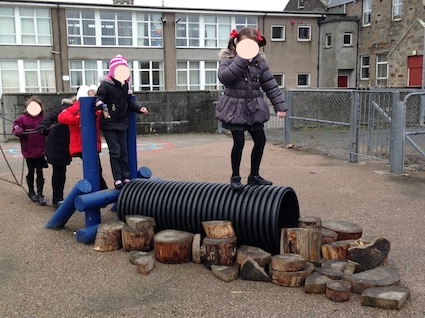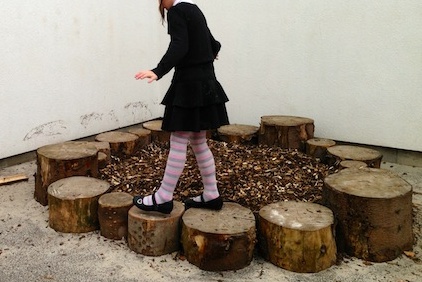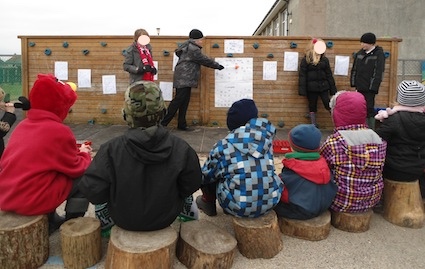*NOTE* This blog post was originally written in June 2013. At the time of writing, having loose stumps around your play space was commonplace. However, some local authorities may have guidelines that expect wooden moveable items to be safely locked away each night to reduce likelihood of arson. Interestingly, play bark as a surface does not seem to be so attention-grabbing. Please check your local and national guidelines and stick to these, regardless of my commentary below. However I’ve left the commentary because from a play perspective, it is better to leave wooden bits out where children leave them. It also saves tidying up. Remember to teach children how to lift and move items sensible if they are heavy. Smaller ones are lighter and easier to carry around. Have a look at the Loose Parts Play: A Toolkit (2019) by Casey and Robertson, p30 for lifting, handling and moving advice. Add this into your risk benefit assessments.
In recent years moveable wooden disks, logs and planks have begun to make an appearance in more and more school grounds that I visit. If you look closely at the photos from the Inverallochy update, you can see the place is littered with wooden bits and pieces. They are a much valued play resource.

The logs are not tidied away at then end of each break or lunchtime. Leaving them in situ allows children to continue the development of a theme or interest day on day. This helps with the creative process. It also sends a hidden message that the school values their work and creations. It’s also stops unnecessary work around developing tidying routines, etc. After all these are natural products which are meant to be left outside.
At the school where I work on Fridays, the Primary 1-3 children have really discovered the fun to be had with these loose parts. One day they have been a “fun bus.” Another time they’ve been a ship. Every day, design changes can be seen in line with the children’s interest and enthusiasm.

Many schools install logs as part of a seating area or circle. This is makes for a lovely naturalised look. I liked this circle at Inverallochy because of the spaces between the logs and the range of heights. There’s one child in Primary 5 who is currently testing himself to jump from log to log. He is very physically able and it’s a real ongoing challenge for him.
At my school, we went for a closer set of logs in one area. The children are very fond of walking around on top of them. We deliberately chose big fat stumps ranging in height from 300-500mm (thanks to my husband for procuring these). We didn’t want the children to be moving them about because it is a much used identifiable feature. We wanted a range of heights to add a bit more challenge to the balancing activities. Last week it was filled with bark chips. It is also used as a social gathering circle for stories, etc.

However moveable logs are extremely handy as portable seating and a lot cheaper than many commercial varieties. It also allows for a bit of choice if there’s enough for this purpose. Inverallochy School sourced their logs from a local firewood supplier. Local ranger services can sometimes advise as can the foresters and tree surgeons.

Increasingly sandpits are lined with logs. This works well too. As adults we tend to see this as the barrier to keep the sand in the pit. But children seem more open-minded. The children at Inverallochy use these for walking along, jumping off, etc. Children tend to view objects around them in terms of their play potential. That’s why children do things like leapfrog over posts or try and run along walls in a parkour style. It’s a normal thing to do as far as a child is concerned.
When I was visiting the Sea Life Centre just outside Oban, the entrance path provided a beautiful example of a log-lined path. This is so child friendly as they can choose their path more creatively. It invites decision-making… walking, running or jumping along a line of logs or the path? Or a combination? Or something else? Hmmm…

All-in-all, I think I’m looking forward to seeing many more creative uses of logs for play outside. Let me know if you’ve seen some good examples.
Sourcing logs: often tree surgeons and landscape gardeners will kindly donate. Likewise local authority arboricultural services may be able to supply. Remember to check for splinters and sand them down prior to play. Children can do this job. Encourage children and/or playworkers to keep regular checks prior to use.
When the logs start to decompose and are no longer so good to play with, then add them to woodpiles so that they can become a habitat for local wildlife.
This blog post was originally published in June 2013.




















Wow… a lovely site, lots lovely safe but wacky ideas. My experience has seen such wonderful ideas from children playing in the outdoors -imaginative, problem solving decision making risk taking etc. etc. so often missed because the value of their experiences are not ‘adult’ outcomes or simply children’s play is not valued. A few examples I had a group of children aged 4/5 and we had a bubble mixture but we did not have the blower – the children came up with their own idea and created a blower by making a small stretched hole through a blade of grass ( as you would for a daisy chain) and used the grass accordingly to blow bubbles from the mixture. It worked. Another example using old cut down branches we used the leaves and using a variety of punchers ( its possible to purchase ones with different shaped patterns -, stars, round or animal shapes) and punch the leaves to create such patterns – children engaged for ages also can bring in language and literacy elements.
Thanks Lesley
That’s a lovely example you’ve given about the children creating a blower. I’ve heard of people hole punching leaves but never tried this myself.